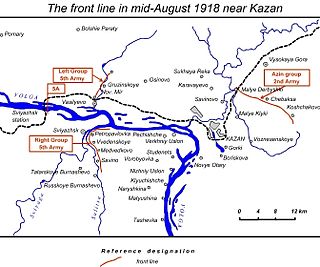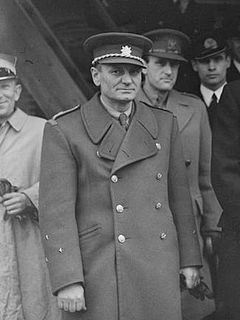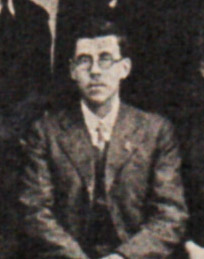 W
WThe Czechoslovak Legion were volunteer armed forces composed predominantly of Czechs and Slovaks fighting on the side of the Entente powers during World War I. Their goal was to win the support of the Allied Powers for the independence of Bohemia and Moravia from the Austrian Empire and of Slovak territories from the Kingdom of Hungary, which were then part of the Austro-Hungarian Empire. With the help of émigré intellectuals and politicians such as the Czech Tomáš Garrigue Masaryk and the Slovak Milan Rastislav Štefánik, they grew into a force of over 100,000 strong.
 W
WThe Czechoslovak Italian Legion was a legion of Czechoslovak volunteers formed late in World War I. The first formal Czechoslovak Volunteers Group was formed in Italian prisoner-of-war camps in Santa Maria Capua Vetere, near Naples and matured at Padula near Salerno. In January 1918, the headquarters of the 6th Italian Army finally agreed to form reconnaissance squadrons from Czechoslovak and Southern Slav volunteers. In September 1918, the 39th Regiment of the Czechoslovak Italian Legion was formed from those volunteer reconnaissance squadrons. The following regiments of Czechoslovak Italian Legion were formed in April and May 1918:31st Regiment in Perugia 32nd Regiment in Assisi 33rd Regiment in Foligno 34th Regiment in Spoleto 35th Regiment was formed in October 1918 from new Czechoslovak prisoners of war in Italy
 W
WEnrollment of Czechoslovak volunteers in the French Foreign Legion started in Paris on 21 August 1914. The 1st Company, Battalion C, of the 2nd Infantry Regiment of the Foreign Legion, was created in Bayonne on 31 August. Meeting in the city, the soldiers greeted each other with "Na zdar!" and hence came to be called "Nazdar!" Company. The company was part of the French army's Moroccan division, and took part in heavy combat during assaults near Arras on 9 May and 16 June 1915, where it suffered heavy casualties. Because of these, Battalion C, including "Nazdar!" Company, was disbanded, and volunteers continued to fight in various French army and Foreign Legion units.
 W
WBattle of Bakhmach, was one of the last battles on the Eastern Front in World War I between the Entente-backed Czechoslovak Legion, Soviet Russia and the Central Powers occupying Ukraine after the Treaty of Brest-Litovsk. The battle lasted from March 8 to March 13, 1918 over the city of Bakhmach (Бахмач), today in Ukraine and was the last engagement in World War 1 for the Soviets. Following a Legion victory, the Germans negotiated a truce.
 W
WThe Battle of Zborov was a part of the Kerensky Offensive. The battle was the first significant action of the Czechoslovak Legions on the Eastern Front and the only successful engagement of the failed Russian offensive.
 W
WThe city of Kazan was captured by the White Army in August 1918 during the Russian Civil War.
 W
WStanislav Čeček was a Czechoslovak general.
 W
WThe Committee of Members of the Constituent Assembly was an anti-Bolshevik government that operated in Samara, Russia, during the Russian Civil War of 1917-1922. It formed on June 8, 1918, after the Czech Legion had occupied the city.
 W
WTomáš Garrigue Masaryk was a Czechoslovak politician, statesman, sociologist, and philosopher. Until 1914, he advocated restructuring the Austro-Hungarian Empire into a federal state. With the help of the Allied Powers, Masaryk gained independence for a Czechoslovak Republic as World War I ended in 1918. He co-founded Czechoslovakia together with Milan Rastislav Štefánik and Edvard Beneš and served as its first president.
 W
WCzechoslovak Legions Graveyard in Vladivostok is a graveyard of the Czechoslovak Legions in Vladivostok, Russia. In total there are buried 163 Czechoslovak legionnaires, who fought in the Russian Far East in between 1918 and 1920. In 2005 the graveyard was reconstructed at the expense of the Czech Republic and in May 2006 it was reopened.
 W
WJan Sergěj Ingr was a Czechoslovak Army four star general and the Minister of National Defense in the Czechoslovak government-in-exile during the Protectorate of Bohemia and Moravia.
 W
WPierre-Thiébaut-Charles-Maurice Janin was a French general and military commander who was the chief of the Allied military mission in Siberia during the Russian Civil War. As such, he commanded the Czechoslovak Legion in Russia. Betrayed and detained Supreme Leader and Commander-in-Chief of All Russian Land and Sea Forces Admiral Alexander Kolchak and handed him over to local Socialist-Revolutionaries in January 1920; soon afterwards the Bolsheviks executed Kolchak in Irkutsk
 W
WJan Jelínek was a Czech legionnaire and author of a book about legionnaires from the Boskovice region. He wrote about legionnaires in Russian, Italian, and French from 1931 to 1938.
 W
WKazan Operation was the Red Army's offensive against the Czechoslovak Legion and the People Army of Komuch during the Russian Civil War.
 W
WThe Revolt of the Czechoslovak Legion comprised the armed actions of the Czechoslovak Legion in the Russian Civil War against Bolshevik authorities, beginning in May 1918 and persisting through evacuation of the Legion from Siberia to Europe in 1920. The revolt, occurring in Volga, Ural, and Siberia regions along the Trans-Siberian Railway, was a reaction to a threat initiated by the Bolsheviks partly as a consequence of the Treaty of Brest-Litovsk. One major secondary consequence of victories by the Legion over the Bolsheviks was to catalyze anti-Bolshevik activity in Siberia, particularly of the Committee of Members of the Constituent Assembly, and to provide a major boost for the anti-Bolshevik or White forces, likely protracting the Russian Civil War.
 W
WJan Syrový was a Czechoslovak Army four star general and the prime minister during the Munich Crisis.
 W
WRudolf Viest was a Slovak military leader, member of the Czechoslovak government in exile, member of the Slovak National Council and the commander of the 1st Czechoslovak army during the Slovak National Uprising. He was the Slovak with the highest military function and the only Slovak general during the interwar period in the first Czechoslovak Republic.
 W
WSergei Nikolaievich Wojciechowski was a Colonel of the Imperial Russian Army, Major-General in the White movement, and Czechoslovak Army general. He was a participant of the Great Siberian Ice March.